Helen Sedwick's Blog, page 10
March 23, 2013
My father's words
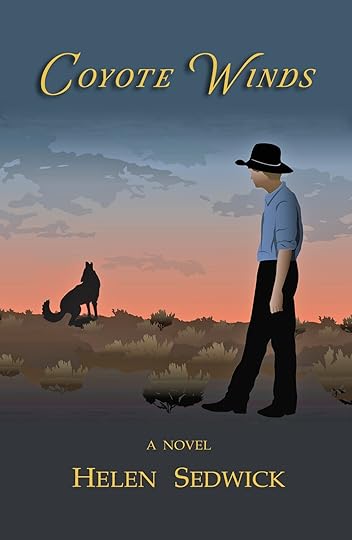 COYOTE WINDS was inspired by my father's stories of growing up in Eastern Colorado in the 1930s. While there was plenty of blowing dust in his stories, he also talked about freedom and adventure. With the schools closed, he spent his days hunting rattlesnakes and rabbits. He collected arrowheads and grasshoppers. He camped out on the prairie grass and counted a thousand shooting stars.
COYOTE WINDS was inspired by my father's stories of growing up in Eastern Colorado in the 1930s. While there was plenty of blowing dust in his stories, he also talked about freedom and adventure. With the schools closed, he spent his days hunting rattlesnakes and rabbits. He collected arrowheads and grasshoppers. He camped out on the prairie grass and counted a thousand shooting stars. I was lucky that my father left a short memoir of those years. After he passed away, I reread the memoir, determined to find some way to use it. I was not ready to say good-bye to Dad.
I wanted to share parts of his memoir with you. Here's Part One.
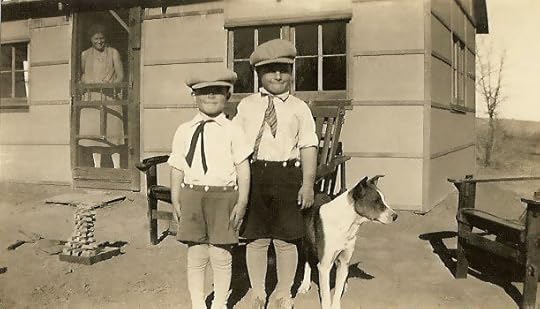
THE GROWING UP YEARSJohn SedwickPREFACEI don't know why it happened, and it is too late to find out now for there is no one to ask, but at the age of around four I found myself living on the rolling, sage brush covered plains of Eastern Colorado. I heard was that my grandmother's health had broken, and she needed to be in a drier climate. Colorado, where a high humidity in the summer might be all of 20%, certainly fulfilled that requirement. I wasn't alone. There was my mother, her sister, Ruth Vincent, my maternal grandmother, Florence Vincent, and my brother, Bob, who was almost two years older than me. The year was 1931.Why Colorado? Well, my maternal grandfather, on a whim one summer when he was a schoolteacher, went out to Colorado to claim some land. I think it was around the turn of the century, but am not sure. You could claim as a homestead a "section" (640 acres) by living on it for 18 months. Or, you could claim a "quarter section" (160 acres) by planting forty acres of trees on it and call it a "timber claim." This is what he did, planted forty acres of ash trees and never saw it again. But, it was in my grandmother's name, so she was the owner.Our property was eleven miles from town, and at first we were living in a two-room deserted shack on the property to the North of ours. There were two rooms - but one was used for corn storage for the people who owned the place. So we had one room for the five of us. We had five folding, collapsible, canvas army cots. I guess some sort of stove. Not much.I remember that during the day it was Bob's and my job to track any rattlesnakes we saw so that the farmer could kill them. That's a job for two boys, 4 and 6 years old, right?
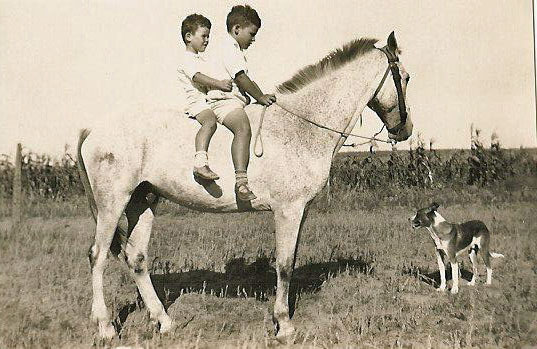 We did get a horse, a white-ish sway-back that we named Spark Plug. But, we never did get a saddle. Any riding was done bare-back. We also were adopted by a dog, a brown "dawg," that we called Barney Google, after the comic strip. (Not the current Internet search engine). Once when Barney had an entanglement with the coyotes and was all torn up, he nursed himself back to health there in the garage. We would bring him food and water, and he would lick his wounds. Within a week he had recuperated. All the local roads around there were just two tracks in the sandy soil, with grass growing up in between. Our Post Master would wear out a car a year with his deliveries. He drove seventy to seventy-five miles a day, as fast as he could over dusty roads, six days a week. About nine o'clock every weekday morning we could look South toward the next hill. We would see a dust cloud forming, and before long would see Fritz's car barreling down toward us. He'd come to a fast stop at the mailboxes there at this corner, get rid of the mail, and careen off on his way. You could set your watch by it. And everything came by mail. No UPS, no FEDEX - just mail. One time we had to order a new axel for our '28 Chevy from the Montgomery Ward catalogue. It came by US mail.And then there a small church, white, with a small steeple that must have been built in better times. Everybody went there on Sunday. It was the only time during a week that you could see other people, have someone to talk to, and put on your "Sunday-go-to-meeting" duds. The "service" was led by Spurgeon Brawley from a weekly scripture mailed to all of us by a religious publishing house in Kansas City, was our weekly Bible lesson - sort of like "mail order religion." What were these people living on? Not much. Besides The Great Depression, there was also a ten-year drought going on in the West, which was later called The Dust Bowl. Most people raised their own food. They would take their milk cans down to the train station to be shipped to a creamery. Prices were very low. I remember eggs at twelve cents a dozen, gas at ten cents a gallon.
We did get a horse, a white-ish sway-back that we named Spark Plug. But, we never did get a saddle. Any riding was done bare-back. We also were adopted by a dog, a brown "dawg," that we called Barney Google, after the comic strip. (Not the current Internet search engine). Once when Barney had an entanglement with the coyotes and was all torn up, he nursed himself back to health there in the garage. We would bring him food and water, and he would lick his wounds. Within a week he had recuperated. All the local roads around there were just two tracks in the sandy soil, with grass growing up in between. Our Post Master would wear out a car a year with his deliveries. He drove seventy to seventy-five miles a day, as fast as he could over dusty roads, six days a week. About nine o'clock every weekday morning we could look South toward the next hill. We would see a dust cloud forming, and before long would see Fritz's car barreling down toward us. He'd come to a fast stop at the mailboxes there at this corner, get rid of the mail, and careen off on his way. You could set your watch by it. And everything came by mail. No UPS, no FEDEX - just mail. One time we had to order a new axel for our '28 Chevy from the Montgomery Ward catalogue. It came by US mail.And then there a small church, white, with a small steeple that must have been built in better times. Everybody went there on Sunday. It was the only time during a week that you could see other people, have someone to talk to, and put on your "Sunday-go-to-meeting" duds. The "service" was led by Spurgeon Brawley from a weekly scripture mailed to all of us by a religious publishing house in Kansas City, was our weekly Bible lesson - sort of like "mail order religion." What were these people living on? Not much. Besides The Great Depression, there was also a ten-year drought going on in the West, which was later called The Dust Bowl. Most people raised their own food. They would take their milk cans down to the train station to be shipped to a creamery. Prices were very low. I remember eggs at twelve cents a dozen, gas at ten cents a gallon. MORE TO COME IN LATER POSTS
Published on March 23, 2013 08:33
March 20, 2013
Guest post on Colorimetry
The guest posts are popping up more quickly now. Laura Armstrong has a visually stunning and always interesting blog. She is giving away a free e-book of COYOTE WINDS. Find my post and the giveaway here Colorimetry Guest Post and Giveaway for COYOTE WINDS,

Published on March 20, 2013 19:31
March 19, 2013
The Voice of the Narrator
I love this article. Steve Almond discusses the use of the narrator's voice to "to portray...how individual fates collide with history, how the orphan survives amid the Industrial Revolution or the aristocrat is brought low by war. These stories don’t just awaken readers’ sympathies; they enlarge our moral imagination. They offer a sweeping depiction of the world that helps us clarify our role in it."
Almond laments that in today's narratives "we’ve traded perspective for immediacy, depth for speed, emotion for sensation, the panoramic vision of a narrator for a series of bright beckoning keyholes."
Interesting insights.
http://www.nytimes.com/2013/01/13/magazine/once-upon-a-time-there-was-a-person-who-said-once-upon-a-time.html?pagewanted=all&_r=0
 I love to slip in the narrator's voice. Most readers think my novel, COYOTE WINDS, is told in three voices; Myles, Andy and Ro. But I use the narrator's voice from time to time. Look at the opening of Chapter Twenty, Rainbows and Rabbits.
I love to slip in the narrator's voice. Most readers think my novel, COYOTE WINDS, is told in three voices; Myles, Andy and Ro. But I use the narrator's voice from time to time. Look at the opening of Chapter Twenty, Rainbows and Rabbits.
Almond laments that in today's narratives "we’ve traded perspective for immediacy, depth for speed, emotion for sensation, the panoramic vision of a narrator for a series of bright beckoning keyholes."
Interesting insights.
http://www.nytimes.com/2013/01/13/magazine/once-upon-a-time-there-was-a-person-who-said-once-upon-a-time.html?pagewanted=all&_r=0
 I love to slip in the narrator's voice. Most readers think my novel, COYOTE WINDS, is told in three voices; Myles, Andy and Ro. But I use the narrator's voice from time to time. Look at the opening of Chapter Twenty, Rainbows and Rabbits.
I love to slip in the narrator's voice. Most readers think my novel, COYOTE WINDS, is told in three voices; Myles, Andy and Ro. But I use the narrator's voice from time to time. Look at the opening of Chapter Twenty, Rainbows and Rabbits.
Published on March 19, 2013 11:02
March 14, 2013
Guest Post on Sheila Deeth's blog
My guest posts are starting to appear. Here's one on Sheila Deeth's Blog. Sheila is a writer of Spiritual Speculative Fiction, Five Minute Bible Stories and other works. She has an informative, lively blog about books and life: Sheila Deeth blog
If the link doesn't work, copy and paste this into your browser.
http://sheiladeeth.blogspot.com/2013/...
Why I Write For Teens:
At 13 years old, I was too nerdy to be a tomboy and too tomboyish to be a nerd. As a middle child, I was too young to be a big girl and too old to be a baby. In school, I did well enough to be called smart, but was too boisterous to be considered good. I hated it—not knowing who I was and where I fit in. I was stuck in the in-between, and it felt awkward, frustrating, and terribly lonely. I write for adolescents in the hope that I can help at least one young reader feel less lonely. Lonely? Today’s teenagers who run in packs and share every thought via smart phone? Frankly, I suspect all that connectivity has only intensified the dilemma of who to trust, respect, or love, and who to avoid, ignore, or fear. With the social terrain shifting so publicly and so quickly, the risk of making a humiliating mistake must be worse than ever. Look at your children’s on-line social media pages. They are portraying themselves as characters, not flesh-and-blood people. They are trying on different masks. Behind those masks, there is vulnerability. Nothing is more lonely than vulnerability. Since I was a teenager, I have always written, whether it was journals, plays, short stories or novels. A few years ago, I took a step back from my writing to see if my work contained any recurring themes. It was easy to see. I came back to it over and over again. My characters were almost always in the process of figuring who they were and what role they played, or were expected to play, within a family. Would they live their lives hidden behind the masks they created or which were handed to them? Or would they find a sense of self other than that mask? Although we face these questions all our lives, they are most palpable during adolescence. I wasn’t aware of this pattern when I started writing COYOTE WINDS, but I certainly see it now. COYOTE WINDS tells the story of two boys living seventy years apart, yet facing similar issues. Growing up on the southern prairie in the 1930s, thirteen-year old Myles tells corny jokes and doesn’t take life seriously. Yet, he wonders if he will ever be a man like his father who “could build barns, string fences, tune a tractor, and plow the straightest furrows,” instead of a boy who “bent nails, splintered boards, and once nearly sawed off his thumb.” He rescues a coyote pup injured in a dust storm, hoping to tame something wild just like his father is taming the land. But as the seasons pass and dust begins to blow, Myles comes to regret following in his father’s footsteps. Compared to Myles’s boyhood, his 21st century grandson Andy feels like he lives in a bunker. He can’t ride a bike without a helmet, play soccer without pads, or ride in a car with a driver under thirty. His mother checks his homework, charts his grades, and warns him that his mistakes will count for the rest of his life. When Andy listens to Grandfather’s Myles’s stories about the prairie, he wishes he too had a unfenced boyhood of hunting rabbits and snaring rattlesnakes. Taking a chance for the first time in his life, he sets out to discover what’s left of the wild prairie. By the end of the novel, both Myles and Andy come to question their parents’ choices and start to make their own. They are moving past the in-between phase. This in-between time of life is awkward, frustrating, and lonely. But also fresh, challenging and exhilarating. By writing for teens I get to feel all of that over and over again.
I wasn’t aware of this pattern when I started writing COYOTE WINDS, but I certainly see it now. COYOTE WINDS tells the story of two boys living seventy years apart, yet facing similar issues. Growing up on the southern prairie in the 1930s, thirteen-year old Myles tells corny jokes and doesn’t take life seriously. Yet, he wonders if he will ever be a man like his father who “could build barns, string fences, tune a tractor, and plow the straightest furrows,” instead of a boy who “bent nails, splintered boards, and once nearly sawed off his thumb.” He rescues a coyote pup injured in a dust storm, hoping to tame something wild just like his father is taming the land. But as the seasons pass and dust begins to blow, Myles comes to regret following in his father’s footsteps. Compared to Myles’s boyhood, his 21st century grandson Andy feels like he lives in a bunker. He can’t ride a bike without a helmet, play soccer without pads, or ride in a car with a driver under thirty. His mother checks his homework, charts his grades, and warns him that his mistakes will count for the rest of his life. When Andy listens to Grandfather’s Myles’s stories about the prairie, he wishes he too had a unfenced boyhood of hunting rabbits and snaring rattlesnakes. Taking a chance for the first time in his life, he sets out to discover what’s left of the wild prairie. By the end of the novel, both Myles and Andy come to question their parents’ choices and start to make their own. They are moving past the in-between phase. This in-between time of life is awkward, frustrating, and lonely. But also fresh, challenging and exhilarating. By writing for teens I get to feel all of that over and over again.
If the link doesn't work, copy and paste this into your browser.
http://sheiladeeth.blogspot.com/2013/...
Why I Write For Teens:
At 13 years old, I was too nerdy to be a tomboy and too tomboyish to be a nerd. As a middle child, I was too young to be a big girl and too old to be a baby. In school, I did well enough to be called smart, but was too boisterous to be considered good. I hated it—not knowing who I was and where I fit in. I was stuck in the in-between, and it felt awkward, frustrating, and terribly lonely. I write for adolescents in the hope that I can help at least one young reader feel less lonely. Lonely? Today’s teenagers who run in packs and share every thought via smart phone? Frankly, I suspect all that connectivity has only intensified the dilemma of who to trust, respect, or love, and who to avoid, ignore, or fear. With the social terrain shifting so publicly and so quickly, the risk of making a humiliating mistake must be worse than ever. Look at your children’s on-line social media pages. They are portraying themselves as characters, not flesh-and-blood people. They are trying on different masks. Behind those masks, there is vulnerability. Nothing is more lonely than vulnerability. Since I was a teenager, I have always written, whether it was journals, plays, short stories or novels. A few years ago, I took a step back from my writing to see if my work contained any recurring themes. It was easy to see. I came back to it over and over again. My characters were almost always in the process of figuring who they were and what role they played, or were expected to play, within a family. Would they live their lives hidden behind the masks they created or which were handed to them? Or would they find a sense of self other than that mask? Although we face these questions all our lives, they are most palpable during adolescence.
 I wasn’t aware of this pattern when I started writing COYOTE WINDS, but I certainly see it now. COYOTE WINDS tells the story of two boys living seventy years apart, yet facing similar issues. Growing up on the southern prairie in the 1930s, thirteen-year old Myles tells corny jokes and doesn’t take life seriously. Yet, he wonders if he will ever be a man like his father who “could build barns, string fences, tune a tractor, and plow the straightest furrows,” instead of a boy who “bent nails, splintered boards, and once nearly sawed off his thumb.” He rescues a coyote pup injured in a dust storm, hoping to tame something wild just like his father is taming the land. But as the seasons pass and dust begins to blow, Myles comes to regret following in his father’s footsteps. Compared to Myles’s boyhood, his 21st century grandson Andy feels like he lives in a bunker. He can’t ride a bike without a helmet, play soccer without pads, or ride in a car with a driver under thirty. His mother checks his homework, charts his grades, and warns him that his mistakes will count for the rest of his life. When Andy listens to Grandfather’s Myles’s stories about the prairie, he wishes he too had a unfenced boyhood of hunting rabbits and snaring rattlesnakes. Taking a chance for the first time in his life, he sets out to discover what’s left of the wild prairie. By the end of the novel, both Myles and Andy come to question their parents’ choices and start to make their own. They are moving past the in-between phase. This in-between time of life is awkward, frustrating, and lonely. But also fresh, challenging and exhilarating. By writing for teens I get to feel all of that over and over again.
I wasn’t aware of this pattern when I started writing COYOTE WINDS, but I certainly see it now. COYOTE WINDS tells the story of two boys living seventy years apart, yet facing similar issues. Growing up on the southern prairie in the 1930s, thirteen-year old Myles tells corny jokes and doesn’t take life seriously. Yet, he wonders if he will ever be a man like his father who “could build barns, string fences, tune a tractor, and plow the straightest furrows,” instead of a boy who “bent nails, splintered boards, and once nearly sawed off his thumb.” He rescues a coyote pup injured in a dust storm, hoping to tame something wild just like his father is taming the land. But as the seasons pass and dust begins to blow, Myles comes to regret following in his father’s footsteps. Compared to Myles’s boyhood, his 21st century grandson Andy feels like he lives in a bunker. He can’t ride a bike without a helmet, play soccer without pads, or ride in a car with a driver under thirty. His mother checks his homework, charts his grades, and warns him that his mistakes will count for the rest of his life. When Andy listens to Grandfather’s Myles’s stories about the prairie, he wishes he too had a unfenced boyhood of hunting rabbits and snaring rattlesnakes. Taking a chance for the first time in his life, he sets out to discover what’s left of the wild prairie. By the end of the novel, both Myles and Andy come to question their parents’ choices and start to make their own. They are moving past the in-between phase. This in-between time of life is awkward, frustrating, and lonely. But also fresh, challenging and exhilarating. By writing for teens I get to feel all of that over and over again.
Published on March 14, 2013 10:45
March 13, 2013
My Book Launch Party ...
was a great success.
 More than 50 people came. Family, friends, and strangers who saw the ad and were interested in the book.
More than 50 people came. Family, friends, and strangers who saw the ad and were interested in the book.
I chatted. I read. I signed dozens of copies. It was elating, validating, and a heck of a lot of fun.
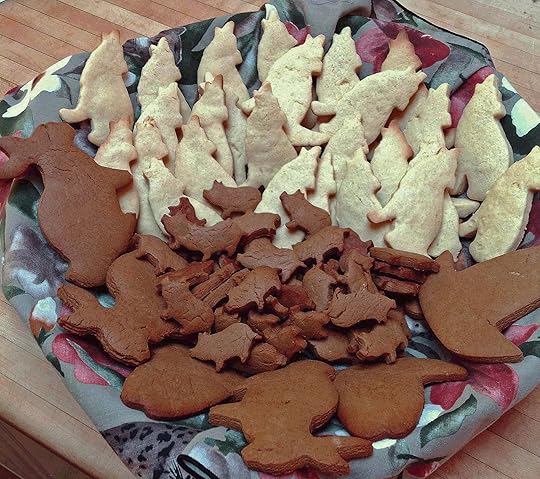 I baked coyote, pig, rabbit and cowboy hat cookies for the occasion (and believe me, when I bake, that's an occasion.)
I baked coyote, pig, rabbit and cowboy hat cookies for the occasion (and believe me, when I bake, that's an occasion.)
I'm ready to do it again. Including the cookies.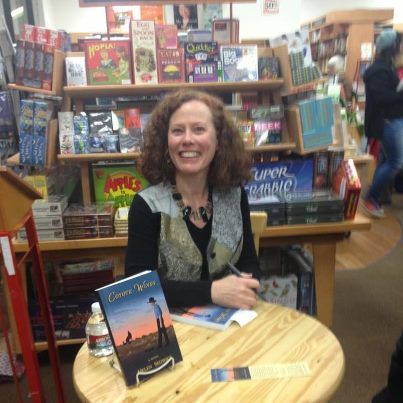
 More than 50 people came. Family, friends, and strangers who saw the ad and were interested in the book.
More than 50 people came. Family, friends, and strangers who saw the ad and were interested in the book.I chatted. I read. I signed dozens of copies. It was elating, validating, and a heck of a lot of fun.
 I baked coyote, pig, rabbit and cowboy hat cookies for the occasion (and believe me, when I bake, that's an occasion.)
I baked coyote, pig, rabbit and cowboy hat cookies for the occasion (and believe me, when I bake, that's an occasion.)I'm ready to do it again. Including the cookies.

Published on March 13, 2013 16:37
March 5, 2013
My Book Trailer is Now on YouTube
My book trailer is up. I want to thank Alexander McDonald for creating it. He did a wonderful job.
http://youtu.be/rdgz9CIJoFs

http://youtu.be/rdgz9CIJoFs

Published on March 05, 2013 20:47
February 16, 2013
Coyotes and Wolves -- Emotional Flashpoints
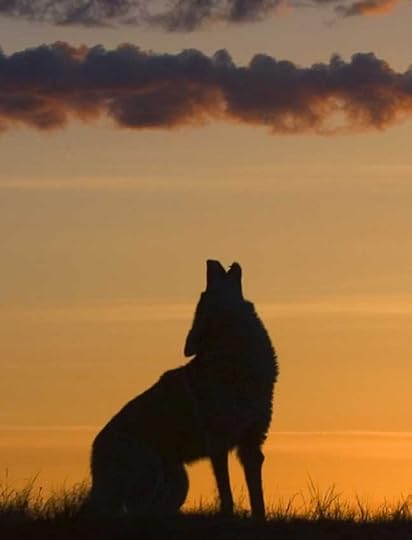 Last weekend’s coyote killing contest in Moduc County, California generated a public outcry against “the gratuitous slaughter of wildlife as part of a contest to win prizes,” as said by Camilla Fox of Project COYOTE (www.projectcoyote.org ). California’s Department of Fish and Wildlife and the Fish and Game Commission were flooded with over 20,000 letters, emails, and petition signatures protesting the contest as murder, gratuitous cruelty, and killing for fun.
Last weekend’s coyote killing contest in Moduc County, California generated a public outcry against “the gratuitous slaughter of wildlife as part of a contest to win prizes,” as said by Camilla Fox of Project COYOTE (www.projectcoyote.org ). California’s Department of Fish and Wildlife and the Fish and Game Commission were flooded with over 20,000 letters, emails, and petition signatures protesting the contest as murder, gratuitous cruelty, and killing for fun. In response, Modoc County Sheriff Mike Poindexter said he won’t “tolerate any restriction of legal hunting on our public lands” (ignoring federal laws prohibiting or regulating coyote hunting on federal lands). He went on to say that he “absolutely will not tolerate any infringement upon your liberties pertaining to accessing or legally hunting on your public lands.”
But it get worse. Wolves cause in traps have been used for target practice. http://www.earthisland.org/journal/index.php/elist/eListRead/wolf_torture_and_execution_continues_in_the_northern_rockies/Trapped coyotes are used to train attack dogs. http://www.sacbee.com/2012/11/02/4956169/us-wildlife-workers-online-photos.html
Board members of anti- trapping organizations have received death threats such as “I would like to donate [sic] a gun to your childs [sic] head to make sure you can watch it die slowly so I can have my picture taken with it’s [sic] bleeding dying screaming for mercy body. YOU WILL BE THE TARGET NEXT B*#CHS!”
Why are coyotes and wolves so hated?
Are they rivals? Historically coyotes, wolves, mountain lions, grizzly bears and bald eagles were considered rivals for food and relentlessly slaughtered, nearly to the point of extinction. But that is not the case anymore. Man won that rivalry long ago.
Are they dangerous? Reports of coyotes and wolves attacking humans are extremely rare, and certainly far fewer than the tens of thousands of attacks perpetrated by dogs. Most so-called attacks are defensive bites when a animal feels trapped or threatened.
Are they thieves? Yes, these predators kill livestock and household pets, and I understand the need to deal with individual predators that become too bold. But the percentage of livestock lost to predators is very small, and a great majority of those who hate coyotes don’t own livestock and have never lost a family pet. And these killing contests are not focused on problem predators. They are free-for-alls. And trapping is indiscriminate and kill thousands of household pets each year, not to mention eagles, otters, bears, and other unintended victims.' Are the killings cost effective? No, predator eradication programs have not lessened the coyote population; in fact they seem to have increased the population. Studies indicate that wolf and coyote populations are self-limiting when there is an alpha breeding pair. If the alpha breeding pair is killed, then more pack members mate and produce offspring. Yet, the Federal Wildlife Service spends a hundred million of our tax dollars each year killing predators, an amount far in excess of the reported losses in livestock. In 2006, the agency reported killing 87,877 coyotes, 2,579 gray foxes, 2,542 red foxes, 2,532 bobcats, 511 badgers, 278 gray wolves, and 265 arctic foxes. The agency did not report how many household pets were killed. http://www.bigwildlife.org/threats2.php
Is this sport? Somehow I can’t see that torturing a trapped animal is sport. Or even trapping for that matter. But see www.Trapperman.com. And thousands of people are members of Predators Masters (Hunting the Hunted) who are proud of luring coyotes to their deaths. http://www.predatormastersforums.com/index.shtml
Why are coyotes and wolves loved?
Because they remind of us dogs? Perhaps. Maybe not so much when they are alive, but the photos of dead wolves and coyotes being shown off as trophies look terribly dog-like. But that's too simple an explanation.
Because they serve an ecological function? Coyotes eat primarily rodents and rabbits, which cause extensive damage crops. When coyotes are eliminated, rodent and rabbit populations balloon. In COYOTE WINDS, I depict a rabbit drive where farmers rounded up and killed thousands of rabbits to control the run-away population. http://www.kshs.org/kansapedia/jackrabbit-drives/12097
 I suspect our emotional responses to coyotes and wolves are closely tied to our view of our relationship to nature. If your view is that we have dominion over nature, then wolves and coyotes, with their defiant, stare you-in-the-eye attitude, challenge this dominion. I try to capture that attitude in one of the characters in COYOTE WINDS. Herbert Moser who warns “the coyote and the prairie are trying to take what’s ours. We got to fight them with all we got.” He also explains he has seven mouths to feed.
I suspect our emotional responses to coyotes and wolves are closely tied to our view of our relationship to nature. If your view is that we have dominion over nature, then wolves and coyotes, with their defiant, stare you-in-the-eye attitude, challenge this dominion. I try to capture that attitude in one of the characters in COYOTE WINDS. Herbert Moser who warns “the coyote and the prairie are trying to take what’s ours. We got to fight them with all we got.” He also explains he has seven mouths to feed. If your view is that man should live in harmony with nature and endeavor to minimize its disruption, then these predators inspire awe and respect. And we fear the consequences of their loss, both ecological and spiritual.
The challenge is finding the right balance.
What is your view?
Below are some informative links:http://www.predatordefense.org/USDA.htm. This site links to a number of informative investigative articles in the Sacramento Bee.http://www.huffingtonpost.ca/shannon-kornelsen/coyote-shot-by-toronto-police_b_2682975.htmlhttp://exposingthebiggame.wordpress.com/2013/02/14/murder-countless-coyotes-win-a-belt-buckle/
Published on February 16, 2013 13:16
January 30, 2013
Haboob--A dust storm by another name
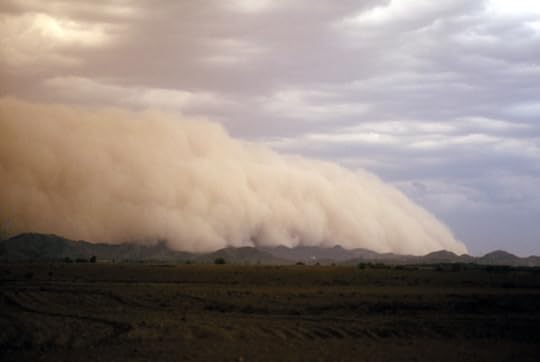
Dust Storms have always occurred and still occur, although not as frequently or as destructively as occurred during the Dust Bowl.
These storms are now called haboobs, perhaps because the term ‘dust storm’ has become so closely associated with the Dust Bowl, a time people would like to forget.
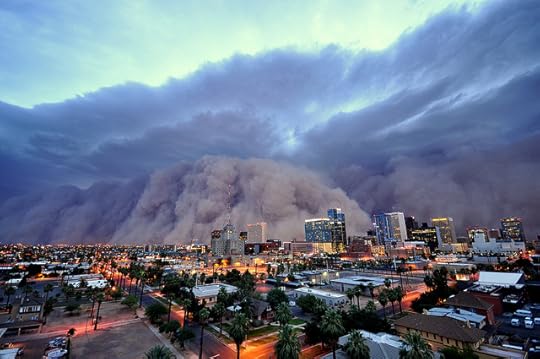 Haboob is an Arabic word. The storms of blowing sand and dirt occur in the Sahara and the Arabian Peninsula, central Australia, and the southwestern United States. Most people don't know that Phoenix has three haboobs a year, on average. Above is a photo of a haboob rolling over Phoenix.
Haboob is an Arabic word. The storms of blowing sand and dirt occur in the Sahara and the Arabian Peninsula, central Australia, and the southwestern United States. Most people don't know that Phoenix has three haboobs a year, on average. Above is a photo of a haboob rolling over Phoenix.Most often haboobs are triggered by the downburst of wind ahead of a thunderstorm. Sixty miles per hour winds lift the sand up to 10,000 feet high. Haboobs last two to three hours and may be followed by rain. If the droplets pass through the dust, they land as wind-driven mud balls.
Look at this incredible time lapse photography by photographer Mike Olbinski of a massive haboob that struck Phoenix, Arizona on July 5, 2011. http://www.youtube.com/watch?v=vYnuzoH5oBA
Haboobs are also triggered by cold fronts blowing across dry land. With the widespread drought in Texas and surrounding states in the last few years, the number of haboobs is increasing. Could it be another Dust Bowl in the making?
If you have ever experienced a haboob or dust storm, please tell us about it in the Comments section below.
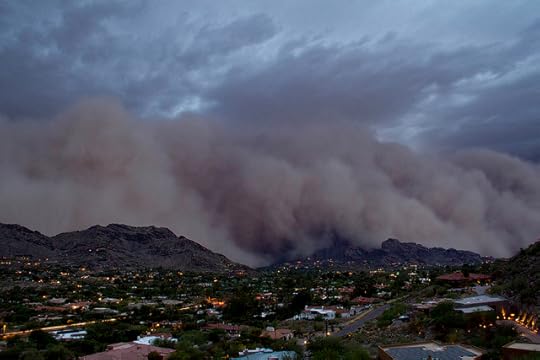
Published on January 30, 2013 20:14
January 25, 2013
A nice review
 I just got a wonderful review from ForeWord. The reviewer's takeaway from the book was exactly what I hoped it would be. It's a wonderful relief to know that I communicated what I wanted, at least to one careful reader. Whew! I espcially like her last line.
I just got a wonderful review from ForeWord. The reviewer's takeaway from the book was exactly what I hoped it would be. It's a wonderful relief to know that I communicated what I wanted, at least to one careful reader. Whew! I espcially like her last line.Here it the review -- including the constructive criticism.
“We were pioneers in a pickup truck.” In 1929, twelve-year-old Myles Vincent’s family headed out to Vona, Colorado, to an abandoned family homestead. Like so many others, Myles’s father, Lionel, believed that with all the new advances in technology, they could farm the Great Plains and fulfill the American Dream.
Years later, Myles shares stories of his life on the prairie with his grandson, Andy. Andy yearns for a bit of the freedom and adventure his grandfather had. When Myles passes away, Andy is haunted by his promise to write down and share his grandfather’s stories. He sets out to learn as much as he can about the time and place his grandfather knew as home—and about the coyote who was such an important part of his life.
Sedwick doesn’t rely solely on historical facts to set the stage for Coyote Wind, nor does she simply state when the novel takes place. Instead, she creates authentic moments that showcase the American West in the 1930s. The time, place, and spirit of the era become as large a part of the novel as the characters, and are equally significant.
Sedwick reminds readers that people are profoundly affected by their time and place, and many of her characters embody that. As a main character, Myles is particularly likeable. He evolves bit-by-bit, in a way that feels realistic. Secondary characters like Myles’s parents and his twin sister are also remarkably strong, and their personal journeys are as important to the story as his own.
At the same time, Andy’s family members seem to serve more of a thematic purpose. To be fair, there is some character development among them, and more time in their company may have felt like a distraction from what lies at the heart of the novel: the story of Myles and Ro, his coyote. As a character, Andy is affable and easy to root for. Like Myles, he slowly evolves into the person he wants to be.
Part of the novel’s strength is how fluidly it reads considering its depth. This is no heavy-handed historical novel. Rather, young readers will be drawn into an engaging story that broaches serious questions about family, the American spirit, and hope. There is the potential for its audience to get so much from the book that it could easily be used in a classroom to prompt discussion."Alicia Sondhi
January 21, 2013
https://www.forewordreviews.com/reviews/coyote-winds/
Published on January 25, 2013 15:09
The $1000 paperback
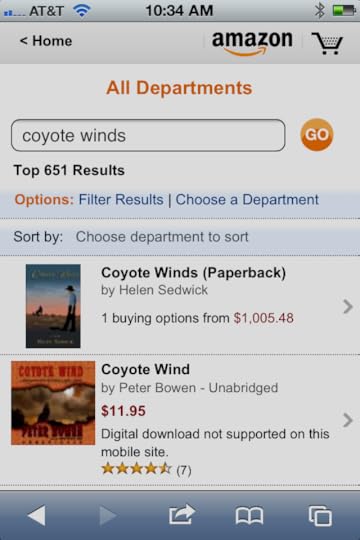 My novel, COYOTE WINDS, will be released in March. A pre-publication/review copy showed up as a used book on Amazon ... at a starting price of $295. The price jumped up several times a day, in odd increments, until it topped $1000. Is this a bizarre market bubble? A computer program gone amok?
My novel, COYOTE WINDS, will be released in March. A pre-publication/review copy showed up as a used book on Amazon ... at a starting price of $295. The price jumped up several times a day, in odd increments, until it topped $1000. Is this a bizarre market bubble? A computer program gone amok? For those of you willing to wait until March, the book will be available for a much more reasonable price.
Published on January 25, 2013 14:58



